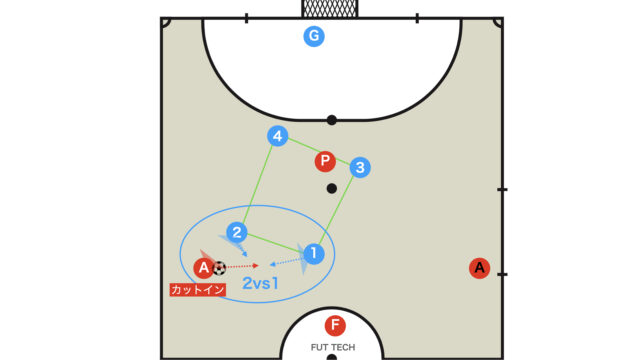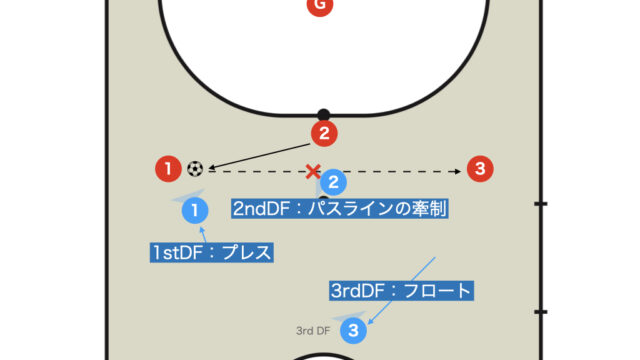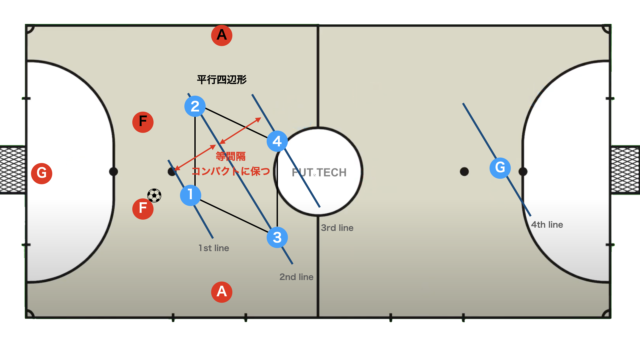For those who are new to futsal, they might think that a man-to-man defence is basically sufficient, right?
In fact, teams made up of futsal beginners often tend to mark individual players too closely, neglecting the coverage behind them.
Of course, a man-to-man defence is undoubtedly one very effective tactic in futsal defensive strategy; however, if the individual abilities are not very high, you must adopt a zone defence that builds multiple DF lines, or the defence will collapse.
Not understanding the concept of multiple DF lines is considered tantamount to not knowing the very basics of futsal tactics, and it is a critically important concept; not only for defence but also for attack, overcoming this DF line is key.
In this article, we will thoroughly explain the fundamental concepts of defence by focusing on the construction of multiple DF lines, which is absolutely essential in futsal defensive tactics, using diagrams and videos.
- Basic Principles of Futsal Offence and Defence
- 3-1 When the fixo Has the Ball
- When the Ball is Passed to the ala
- 2nd Line: The Degree of Narrowing on the Opposite Side
- Awareness of Covering: Anticipation and Judgment
- Bad Example ①: 1st Line and 2nd Line are Too Close
- Bad Example ②: 1st Line and 2nd Line are Too Far Apart
- Bad Example ③: Failing to Cut Between the Alas
- Summary
Basic Principles of Futsal Offence and Defence
Futsal is a sport where victory is achieved by scoring more goals than the opponent while conceding fewer.
To win by scoring goals, you must shoot, and to take shots with a higher probability, it is crucial to find space to dismantle the opponent’s defensive organization and make effective use of that space.
In other words, in futsal, the attack is all about creating, finding, and effectively using space, and considering that offence and defence are two sides of the same coin, it is equally important for defence to fill space and prevent the opponent from making effective use of it.
Simply put, futsal can be seen as a sport of space.
Therefore, in futsal defence, it is necessary to construct multiple DF lines in order to cover more space.
The more DF lines there are, the greater the safety; ideally, three to four lines (columns) should be formed with five players, including the Goleiro.
Taking these factors into account, the basic principles of offence and defence can be summarized as follows:
- Offence: Force the opponent’s defensive lines apart or cause them to absorb each other
- Defence: Keep the defensive lines compact and ensure they never form a single line
These basic principles are extremely important.
Now, let’s take a closer look at what this really means.
3-1 When the fixo Has the Ball
While the construction of multiple defensive lines is an important concept throughout futsal defence, in this instance we will explain the defence against the tactic involving the positioning of a false pivo in a 3-1 formation.
When the fixo has the ball, player Blue No.1 presses the ball holder, while Blue No.2 and Blue No.3 in the second line maintain a distance that prevents the opponent’s ala from getting behind them.
At this time, if they cling too tightly to the red ala or close the distance too aggressively when the ball is at the opponent’s feet, they can be easily backdoor.
Basically, when a defender with their back to the goal and an attacking opponent sprint simultaneously in a contest, the offence wins; therefore, defenders must take this into account and maintain an appropriate distance.
Anticipate the pass from the fixo to the ala, start moving before the ball is passed, get as close as possible to the opponent, and be sure to stop the moment the opponent traps the ball, so as not to be easily bypassed by moves such as contrapie.
Defenders applying pressure should fundamentally position themselves between the goal and the ball, while also being mindful of cutting passing lanes in consideration of the opponent’s dominant foot.
When the Ball is Passed to the ala

When the ball is passed to the ala, player Blue No.1 takes appropriate positioning by cutting a route from one ala to the other, as shown in the diagram.
The importance of cutting between the alas will be explained later.
Player Blue No.2 should not stick closely to the opposite-side ala; instead, by slightly narrowing the gap, they must be ready to cover in case the opponent breaches the 1st DF line.
2nd Line: The Degree of Narrowing on the Opposite Side
The degree to which Blue No.2 narrows depends on their agility and defensive range, but at a minimum, it is desirable to narrow up to the extension of the post on the side farthest from the ball, as shown in the diagram.
It is advisable for the team to decide in advance to what extent the narrowing should be.
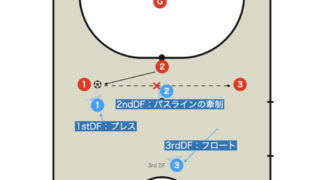
Awareness of Covering: Anticipation and Judgment
As shown in the diagram above, when the ball holder (the ala) attempts a vertical breakthrough, Blue No.2 starts moving in anticipation of the 1st line being breached.
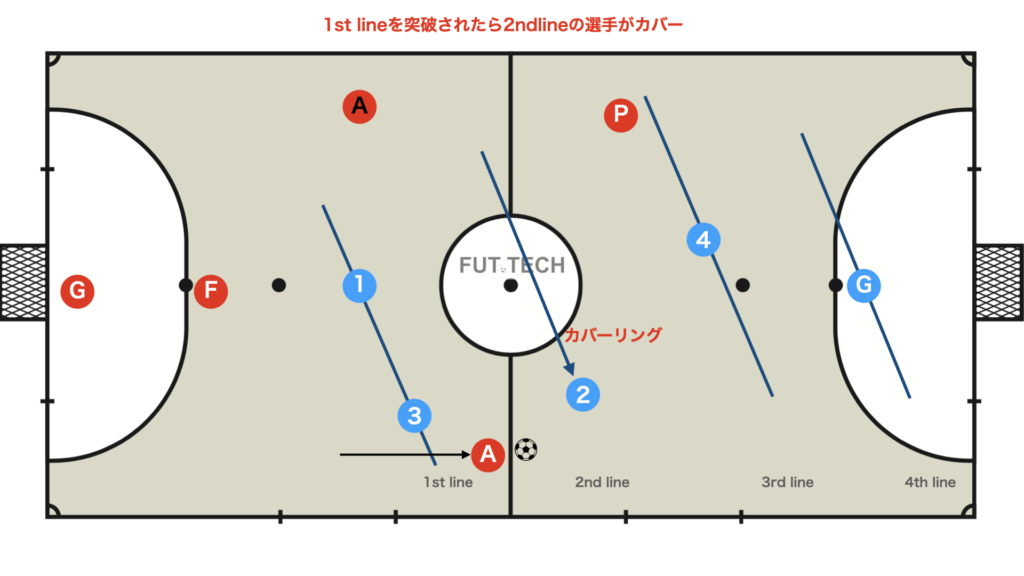
Review this sequence through an actual match video.
Bad Example ①: 1st Line and 2nd Line are Too Close

This is a typical bad example that futsal beginners frequently commit.
Blue No.2 gets so caught up in marking the opponent (red ala) that the 1st line is left uncovered.
At first glance, it may appear that multiple lines have been formed as shown above, but if the defensive lines are too close, they overlap and function as only a single line (column).
In other words, in this situation, including the Goleiro, effectively only three lines are formed.
Such a phenomenon in futsal is referred to as the absorption of multiple DF lines.
An effective tactic that causes this absorption of multiple DF lines is the 3 on line formation (where three players line up horizontally).
If you cannot cover the vertical breakthrough by the alas in this manner, it can result in a 2 vs 1 (or 2 vs 2 including the Goleiro) situation, creating a numerical disadvantage and significantly increasing the risk of conceding a goal.
This is an example that deeply demonstrates the importance of constructing multiple DF lines.
Bad Example ②: 1st Line and 2nd Line are Too Far Apart

At first glance, it may seem that Blue No.2 is effectively covering in preparation for a breach of the 1st line by narrowing appropriately, but if the 1st and 2nd lines are too far apart, it is not ideal.
If the gap between the lines is too wide, the opponent can easily exploit the entre lineas.
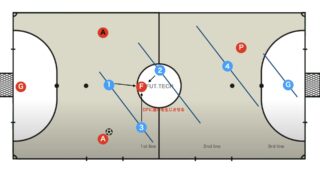
If the defensive lines are too far apart, the covering—which should be effective—won’t function efficiently, thereby providing a wide space that enables play between the lines.
If the opponent exploits the space between the lines, it can cause confusion among the defenders and potentially collapse the organized defence.
In other words, the distance between the defensive lines must be neither too close nor too far, but just right.
Bad Example ③: Failing to Cut Between the Alas
If the passing lane between the alas is not cut, not only can the 1st line be easily breached, but the opponent can also execute a side change, causing delays in the coordinated defensive slide, which is disastrous.
As shown in the diagram above, this results in defensive confusion and a temporary breakdown of the organisation.
This is why the term ala-ala is often heard during futsal matches.
Additionally, there is a fundamental principle in futsal defence that skips in passing are generally not allowed.
Summary
This time, we explained the very important fundamental principle in futsal defence – the construction of multiple lines.
For those who are new to futsal, it might be difficult to grasp all these concepts at once, so please review this article several times.
If you can master these basic principles,
- At what height should the press be set, and where should the lines be positioned?
- How frequently should marking exchanges be carried out?
- In what formation should the defence be arranged?
- Should it be a zone, a mix, or man-to-man?
- With what intention, objective, location, and intensity should the press be executed?
By incorporating these elements, an organized defence can be achieved.
We are also sharing many other useful insights, so please check them out if you’re interested!

Thank you very much for reading this article to the end.
If you found this article useful, please consider sharing it using the social media share buttons above.
We regularly share valuable insights on futsal tactics on Twitter, so if you haven’t followed us yet, we’d appreciate your support!
We are committed to raising the level of futsal in Japan by sharing high-quality information through discussions with individuals who have coaching experience in the F.League and overseas.
If you have any questions or notice any mistakes, feel free to leave a comment below.
We update our articles regularly, so if you’d like to keep reading, please bookmark our site or search for “FutTech”!
